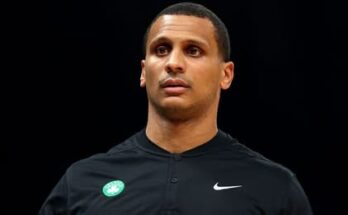Alabama Crimson Tide Fall Camp Heats Up as Position Battles Intensify and Talented Young Players Begin to Rise in Competitive Environment
As the blistering August sun blankets Tuscaloosa, the Alabama Crimson Tide have officially turned the page to one of the most critical stretches of their offseason: fall camp. This isn’t just another preseason warm-up or a series of routine practices. For Alabama, fall camp is a proving ground—a fierce battleground where depth charts are challenged, veterans are pushed by hungry underclassmen, and the foundation of a championship-caliber roster is carefully sculpted by competition, urgency, and daily accountability. And this year, all eyes are zeroed in on two central themes—position battles that could swing the season and young players who are not just flashing potential but demanding attention.
Alabama’s annual fall camp is known for its intensity and high-level execution, a microcosm of the program’s “standard over everything” ethos that has defined its reign under Nick Saban and is now being ushered forward into a new era under head coach Kalen DeBoer. Though the coaching transition brought uncertainty from the outside, internally the Crimson Tide haven’t missed a beat. DeBoer’s system is new, his staff is partially rebuilt, and the schematics are evolving, but the DNA remains the same—win your rep, outwork your competition, and rise to the challenge.
Perhaps the most captivating storyline emerging from camp is the wave of position battles that have injected daily intensity into each practice. Nowhere is this more apparent than at the quarterback position. While Jalen Milroe enters as the presumptive starter after a rollercoaster 2023 season that saw him show flashes of brilliance along with growing pains, the competition behind him is far from quiet. Ty Simpson, known for his arm strength and quick processing, has come into camp looking sharper and more decisive. Then there’s Dylan Lonergan, the second-year gunslinger who has drawn quiet praise from coaches for his poise and accuracy. While Milroe maintains a grip on QB1 duties for now, it’s clear that the coaching staff isn’t handing anyone anything based on last year’s résumé. Every throw matters. Every read is evaluated. Every misstep is noted. The quarterback room is more competitive than ever, and that’s exactly how DeBoer wants it.
The running back room also presents intrigue, not due to a lack of talent but rather an overwhelming surplus. Jase McClellan’s departure opens the door for a new lead back, and while Roydell Williams brings veteran steadiness and a punishing running style, it’s the younger players who are making the most noise early in camp. Jam Miller’s burst has caught eyes. Justice Haynes, the second-year back who arrived as a top-five national recruit in 2023, looks like he’s taken a significant leap forward both physically and mentally. His vision has improved, his pass protection has become more reliable, and he’s making a strong case to be featured heavily in the rotation. Then there’s true freshman Kevin Riley, who has wasted no time introducing himself to the older players with a string of impressive runs that have turned heads. This is a group that might not have a single 30-carry-per-game bell cow, but rather a stable of dynamic backs capable of wearing defenses down by committee—and it’s the younger backs pushing that narrative.
Out wide, Alabama is watching a youth movement unfold before its eyes. While veterans like Ja’Corey Brooks and Isaiah Bond bring experience and trust, the underclassmen have brought a different kind of fire to the receiving corps. Sophomore Kendrick Law has emerged as a reliable target with strong hands and excellent route-running precision, while Malik Benson has begun to tap into the elite speed and downfield ability that made him a coveted JUCO prospect. Still, the freshman class has been perhaps the most intriguing. Ryan Williams, the reclassified five-star phenom, is already making waves in camp with his crisp footwork, explosive breaks, and maturity beyond his years. Amari Jefferson has also shown promise, demonstrating physical toughness and the ability to separate in traffic. With the Tide looking to revamp their passing game under new offensive coordinator Nick Sheridan, these younger weapons could carve out legitimate roles if they continue their ascension.
On the offensive line, the battle for starting roles is as ferocious as ever. JC Latham’s return solidifies one tackle spot, but there’s still work to be done across the rest of the line. The center position is a key area of focus, with James Brockermeyer and Parker Brailsford locked in a day-to-day competition that’s too close to call. Brailsford, a transfer from Washington following DeBoer, has familiarity with the offensive system and has proven to be a cerebral anchor for the group. Brockermeyer, on the other hand, has patiently waited for this shot and is not letting the opportunity pass without a fight. Freshman Casey Poe is another name emerging from the trenches. He’s been physical, aggressive, and ahead of schedule in terms of mental processing. This group may look different week to week in camp, but that’s by design—competition breeds excellence, and Alabama is determined to identify the best five by letting the cream rise naturally.
Defensively, things are equally competitive. The defensive line is loaded with veteran muscle and young explosiveness. Tim Keenan III and Jaheim Oatis provide a stout presence in the middle, but it’s the young edge rushers who are adding juice. Keon Keeley, one of the most celebrated signees in recent memory, has brought bend, burst, and improved hand usage to fall camp. Qua Russaw is also coming into his own, and together with Dallas Turner leading the way, Alabama’s edge group looks as dangerous as ever.
Linebacker is a position of transition following the loss of stalwarts like Deontae Lawson. Yet again, youth is stepping up. Jihaad Campbell, a long, athletic playmaker, looks ready to take on a larger leadership role. Freshmen Sterling Dixon and Justin Jefferson have made waves during scrimmages and 7-on-7 periods. Though they may not start immediately, their physical tools and mental approach are ahead of schedule.
Perhaps the most stacked and contentious area of camp is the secondary. Alabama’s defensive backs are deep, fast, and versatile. Kool-Aid McKinstry anchors the cornerback unit, but the other starting spots remain up for grabs. Earl Little Jr. is emerging as a top candidate at star, showing improved coverage ability and confidence. Freshman Zabien Brown has turned heads at corner with his foot speed and ball tracking. The safety room is even more competitive. Malachi Moore is the veteran presence, but young talents like Peyton Woodyard and Tony Mitchell are challenging for playing time. Mitchell, in particular, has been a revelation in camp after missing time last year. He looks faster, stronger, and more prepared for the physicality of SEC play.
It’s also worth noting that special teams haven’t been overlooked during the frenzy of positional competition. Alabama is trying out several options at kicker and punter, and the return game is seeing contributions from both veterans and freshmen alike. Ryan Williams has shown flashes as a punt returner, and his electric playmaking ability could earn him touches outside of the offense.
While the competition across the board is intense, one of the most refreshing aspects of this year’s fall camp has been the energy brought by the young players. These freshmen and second-year athletes aren’t just practicing—they’re performing. They’re pushing veterans. They’re forcing coaches to reconsider established depth charts. And they’re embodying the next generation of Alabama football in real time. Whether it’s the quiet confidence of a polished route, the aggressive pop of a clean tackle, or the vocal leadership from an unexpected source, the young talent is not waiting their turn—they’re taking it.
That competitive fire is exactly what DeBoer and his staff want. Alabama has built its identity on talent, yes, but more importantly on internal pressure. The pressure to perform every day. The pressure to fight for every snap. The pressure to uphold the standard set by those who came before. That internal culture doesn’t rebuild itself—it must be reignited every offseason. This fall camp is doing just that. The veterans are being tested, the newcomers are being forged in competition, and the coaches are watching it all unfold to determine who’s ready for primetime.
As Alabama barrels toward the season opener, fall camp continues to be the crucible where leadership is defined, schemes are refined, and roles are earned. Every day brings new data, new observations, and new storylines. The quarterback reps, the battles in the trenches, the emergence of star freshmen—it’s all part of a process that will ultimately shape the 2025 version of the Alabama Crimson Tide.
And if fall camp has revealed anything so far, it’s this: Alabama isn’t rebuilding. They’re reloading. And the next wave of Crimson Tide talent is rising fast.



